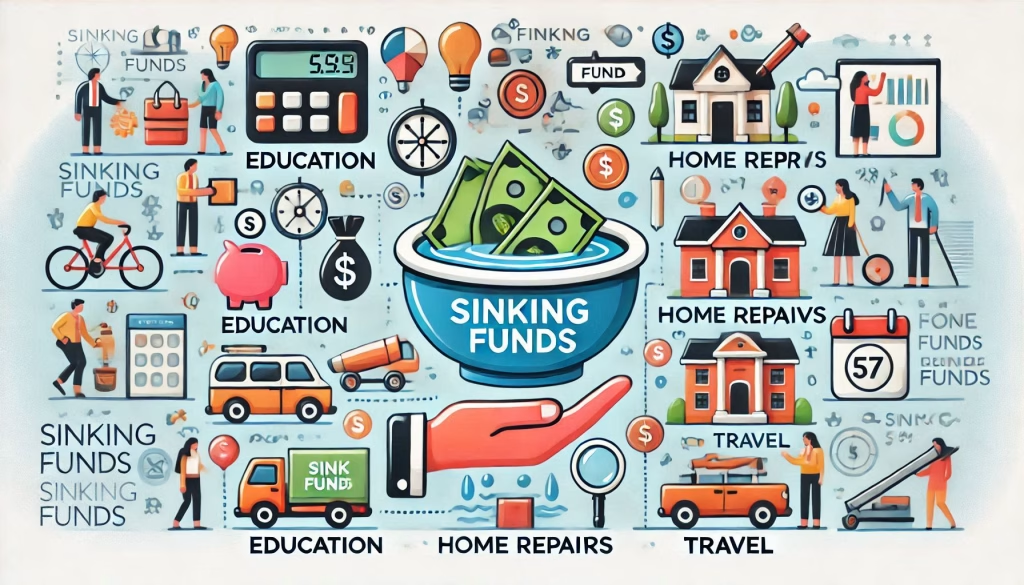Table of Contents
- Overview
- What is a Sinking Fund?
- Advantages of Adopting a Sinking Fund Approach
- Financial Preparedness
- Reduced Financial Stress
- Avoiding Debt
- Improved Budgeting
- Goal Achievement
- Flexibility and Customization
- Financial Discipline
- Emergency Preparedness
- Enhanced Financial Awareness
- Long-Term Financial Benefits
- Setting Money Aside More Easily
- Capable of Planning Significant Expenditure Allocation
- Being Better Prepared for Inevitable Expenses
- How to Set Up a Sinking Fund
- Types of Sinking Funds
- Strategies for Building a Sinking Fund
- Common Mistakes to Avoid
- The Conclusion
Overview
It’s essential for everyone to have financial goals, whether for the short term or long term. Typically, to reach these financial goals, many people opt to save money. However, it may be surprising to learn that there are various types of savings, each tailored to different goals and strategies.
A sinking fund is one such financial tool. Often, those unfamiliar with the term may confuse it with regular savings. However, a sinking fund is distinct in its goals and methods. While savings might accumulate as an emergency fund, a sinking fund typically serves a more targeted objective.
Additionally, the funds accumulated in a sinking fund are frequently utilized to prepare for significant expenditures. But what exactly does a sinking fund entail? Moreover, what advantages does a sinking fund offer, and what is the most effective method for accumulating it?
In the realm of personal finance, the concept of a sinking fund often goes unnoticed, yet it holds immense potential for achieving specific financial goals. A sinking fund is a strategic savings tool designed to accumulate money over time for a particular purpose, such as a major purchase, a vacation, or even unexpected expenses. By understanding and mastering the sinking fund, you can take control of your finances and ensure that you are well-prepared for future financial needs.
What is a Sinking Fund?

As previously mentioned, a sinking fund is a financial strategy that differs in approach and objectives from a regular savings account. Unlike emergency savings, sinking funds typically have a more defined purpose and are designated by their owners for significant expenditures.
A sinking fund is generally defined as a type of savings account that is established for a predetermined purpose. For instance, such a fund may be allocated for the repayment of debt obligations or to serve as investment capital.
A sinking fund is a dedicated savings account where you regularly set aside money for a specific financial goal. Unlike a general savings account, a sinking fund is earmarked for a particular purpose, making it easier to track progress and stay motivated. The term “sinking fund” originates from corporate finance, where companies set aside money to repay debt or replace assets. However, the concept is equally valuable for personal finance.
Sinking funds, as opposed to other savings types like emergency funds, offer the benefit of being allocated for specific purposes or expenses. Moreover, this approach to saving is typically considered safer and more secure.
A sinking fund differs from regular savings; it operates in a straightforward and manageable manner. Essentially, sinking funds are designed to be simple and easy to implement.
To implement this strategy, simply allocate a specific nominal amount of funds each month. These funds should then be distributed across various preselected financial categories. Additionally, each category or financial allocation for the sinking fund should be associated with a date indicating when the funds will be utilized.
Thus, you can allocate funds consistently and with discipline, in line with your financial capacity, without the need to immediately set aside a large sum, ensuring your financial objectives are met. For instance, you might be saving up to purchase birthday presents or to set up a budget for a vacation.
Clear financial goals that require accumulation by a specific time are considered sinking funds. An example would be saving for a mortgage down payment that is planned for the following year.
Advantages of Adopting a Sinking Fund Approach

Implementing a sinking fund strategy not only simplifies the allocation of funds to meet specific financial goals within a set timeframe, but it also offers numerous advantages. These benefits typically pertain to modifications and simplifications in the budgeting process.
In the world of personal finance, the sinking fund approach is a powerful yet often underutilized strategy. A sinking fund is a dedicated savings account where you regularly set aside money for a specific purpose, such as a major purchase, a vacation, or unexpected expenses. By adopting a sinking fund approach, you can achieve greater financial stability, reduce stress, and avoid debt. In this article, we will explore the numerous advantages of using a sinking fund and how it can benefit your financial well-being.
Advantages a Sinking Fund Approach No.1
InsuranceWhat.com
Financial Preparedness
One of the primary advantages of adopting a sinking fund approach is financial preparedness. By setting aside money for specific goals, you ensure that you have the necessary funds available when you need them. This can be particularly beneficial for planned expenses, such as buying a new car, renovating your home, or taking a vacation. Instead of scrambling to find the money when the time comes, you can confidently make the purchase knowing that you have already saved for it.
Advantages a Sinking Fund Approach No.2
InsuranceWhat.com
Reduced Financial Stress
Financial stress is a common issue for many people, often stemming from the uncertainty of how to cover large expenses. A sinking fund can significantly reduce this stress by providing a clear plan for saving and spending. Knowing that you have money set aside for specific purposes can give you peace of mind and help you feel more in control of your finances. This can lead to improved mental and emotional well-being, as you are less likely to worry about unexpected financial challenges.
Advantages a Sinking Fund Approach No.3
InsuranceWhat.com
Avoiding Debt
One of the most significant benefits of a sinking fund is the ability to avoid debt. When you save for future expenses in advance, you are less likely to rely on credit cards or loans to cover the costs. This can help you maintain a healthy financial profile and avoid the high interest rates and fees associated with borrowing money. By using a sinking fund, you can make purchases and cover expenses without accumulating debt, which can have long-term positive effects on your financial health.
Advantages a Sinking Fund Approach No.4
InsuranceWhat.com
Improved Budgeting
A sinking fund encourages disciplined budgeting and financial planning. By allocating a portion of your income to specific goals, you can better manage your finances and avoid overspending. This can help you stay on track with your budget and ensure that you are consistently saving for your future needs. Additionally, having a sinking fund can make it easier to track your progress and adjust your budget as needed to meet your goals.
Advantages a Sinking Fund Approach No.5
InsuranceWhat.com
Goal Achievement
Setting and achieving financial goals is an essential aspect of personal finance. A sinking fund provides a clear path to reaching your objectives by allowing you to save for specific purposes. Whether it’s buying a new appliance, funding a child’s education, or planning a dream vacation, a sinking fund helps you stay focused and motivated. By regularly contributing to your sinking fund, you can make steady progress toward your goals and celebrate your achievements along the way.
Advantages a Sinking Fund Approach No.6
InsuranceWhat.com
Flexibility and Customization
A sinking fund offers flexibility and customization to suit your unique financial needs. You can create multiple sinking funds for different purposes, each with its own savings target and timeline. This allows you to prioritize your goals and allocate your resources accordingly. For example, you might have separate sinking funds for home repairs, holiday expenses, and a new car. By customizing your sinking funds, you can ensure that you are saving for all of your important financial goals.
Advantages a Sinking Fund Approach No.7
InsuranceWhat.com
Financial Discipline
Adopting a sinking fund approach promotes financial discipline and responsible money management. By consistently setting aside money for specific purposes, you develop good saving habits and become more mindful of your spending. This can help you avoid impulsive purchases and make more informed financial decisions. Over time, the discipline you develop through using a sinking fund can lead to greater financial stability and success.
Advantages a Sinking Fund Approach No.8
InsuranceWhat.com
Emergency Preparedness
While sinking funds are often used for planned expenses, they can also be a valuable tool for emergency preparedness. By setting up an emergency fund as one of your sinking funds, you can ensure that you have money available for unexpected expenses, such as medical bills, car repairs, or job loss. This can provide a financial safety net and help you avoid going into debt during emergencies. Having an emergency sinking fund can give you peace of mind and help you navigate financial challenges with confidence.
Advantages a Sinking Fund Approach No.9
InsuranceWhat.com
Enhanced Financial Awareness
Using a sinking fund can enhance your financial awareness and understanding. By regularly contributing to your sinking funds and tracking your progress, you become more attuned to your financial situation and goals. This increased awareness can help you make better financial decisions and identify areas where you can improve your saving and spending habits. Additionally, the process of setting up and managing sinking funds can provide valuable insights into your financial priorities and long-term objectives.
Advantages a Sinking Fund Approach No.10
InsuranceWhat.com
Long-Term Financial Benefits
The long-term benefits of adopting a sinking fund approach are substantial. By consistently saving for specific goals and avoiding debt, you can build a strong financial foundation for the future. This can lead to greater financial security, the ability to achieve your dreams and aspirations, and a more comfortable and fulfilling life. The habits and discipline you develop through using a sinking fund can have lasting positive effects on your financial well-being and overall quality of life.
Advantages a Sinking Fund Approach No.11
InsuranceWhat.com
Setting Money Aside More Easily
One of the primary benefits of establishing a sinking fund is the ease of setting aside funds. This is because the savings plan is designed with a specific and detailed objective in mind. A sinking fund plan not only clarifies the purpose but also specifies the timing and the exact needs for which the funds will be utilized.
For instance, if you intend to allocate funds for a vacation budget at the year’s end, it’s beneficial to determine the specific purpose of these savings, including the target amount and the expenses that will be covered. This budgeting approach ensures that fund allocation is focused and facilitates the process of saving until the financial objective is reached.
Advantages a Sinking Fund Approach No.12
InsuranceWhat.com
Capable of Planning Significant Expenditure Allocation
Achieving financial goals often involves large expenses such as purchasing a vehicle, setting aside vacation funds, or renovating a home. Due to the substantial amounts involved, the task of saving can sometimes become more challenging.
Fortunately, the sinking fund strategy offers a way to circumvent financial challenges. This approach allows for the systematic setting aside and accumulation of funds, granting complete control over their management and ensuring their intended use.
Advantages a Sinking Fund Approach No.13
InsuranceWhat.com
Being Better Prepared for Inevitable Expenses
Implementing a sinking fund strategy clarifies your financial planning regarding expenses and future needs. Early comprehension of these funds’ utilization also equips you to better handle inevitable expenses, whether they are expected or unforeseen.
For instance, if you’ve allocated funds specifically for vehicle maintenance, and one day you notice that your car tires are wearing thin and need replacing, you’re in luck. Since you’ve already set aside the money, you can address this issue right away without the stress of having to save up beforehand.
How to Set Up a Sinking Fund

A sinking fund is a powerful financial tool that can help you save for specific goals and expenses. Unlike a general savings account, a sinking fund is dedicated to a particular purpose, making it easier to track your progress and stay motivated. Whether you’re saving for a vacation, a new car, or an emergency fund, setting up a sinking fund can provide financial security and peace of mind. In this article, we’ll explore the steps to set up a sinking fund and how to manage it effectively.
Setting up a sinking fund involves several key steps. Here’s a detailed guide to help you get started:
How to Set Up a Sinking Fund No.1
InsuranceWhat.com
Identify Your Goals
The first step in setting up a sinking fund is to identify your financial goals. These goals can be short-term or long-term, and they should be specific and measurable. Examples of sinking fund goals include:
- Saving for a vacation
- Building an emergency fund
- Saving for a down payment on a house
- Setting aside money for home repairs
- Saving for a new car
- Planning for holiday expenses
How to Set Up a Sinking Fund No.2
InsuranceWhat.com
Determine the Timeframe
Once you have identified your goals, determine the timeframe within which you want to achieve them. This will help you calculate how much you need to save each month to reach your target. For example, if you want to save $1,200 for a vacation in 12 months, you would need to save $100 per month.
How to Set Up a Sinking Fund No.3
InsuranceWhat.com
Calculate Monthly Contributions
To calculate your monthly contributions, divide the total amount you need by the number of months until your goal date. This will give you the monthly contribution required to reach your goal. For example, if you need $5,000 for a home renovation in 10 months, you would need to save $500 per month.
How to Set Up a Sinking Fund No.4
InsuranceWhat.com
Open a Dedicated Account
Open a separate savings account specifically for your sinking fund. This will help you keep your sinking fund money separate from your regular savings and make it easier to track your progress. Many banks offer accounts with no minimum balance requirements and no monthly fees, making it easy to set up a dedicated sinking fund account.
How to Set Up a Sinking Fund No.5
InsuranceWhat.com
Automate Your Savings
Set up automatic transfers from your checking account to your sinking fund account. This ensures that you consistently save the required amount each month without having to remember to do it manually. Automating your savings can help you stay on track and avoid the temptation to spend the money elsewhere.
How to Set Up a Sinking Fund No.6
InsuranceWhat.com
Monitor and Adjust
Regularly monitor your sinking fund to ensure that you are on track to meet your goals. If necessary, adjust your contributions to account for changes in your financial situation or unexpected expenses. For example, if you receive a bonus at work, consider allocating a portion of it to your sinking fund to accelerate your progress.
How to Set Up a Sinking Fund No.7
InsuranceWhat.com
Identifying the Reasons for Saving Money
The first tip to be able to prepare a sinking fund optimally is to determine the purpose of storing the fund clearly and in detail. For example, you have plans to go on vacation early next year and also prepare funds to meet your needs afterwards. Through this planning, you don’t need to be too wasteful and the funds to meet your daily needs are still available even after taking a vacation.
How to Set Up a Sinking Fund No.8
InsuranceWhat.com
Determine the Financial Instrument to Save It
Once you have identified the goals you wish to achieve, the subsequent step in preparing this type of savings is to select a suitable container or financial instrument for storage. Naturally, the choice of financial instrument will vary based on the purpose and duration of the savings plan.
Primarily, it’s important to maintain a separate account for daily expenses. If needed, employ investment tools to accumulate these funds more effectively. For added security, opt for straightforward and convenient investment options like mutual funds or fixed deposits.
How to Set Up a Sinking Fund No.9
InsuranceWhat.com
Preparing a Sinking Fund in Accordance with Financial Circumstances
It’s crucial when dealing with sinking funds to verify that the required deposits align with the budget and financial circumstances. No matter the strategy, if the required fund amount surpasses financial means, it will be unattainable. Thus, it’s important to establish a sinking fund that reflects your financial situation.
Types of Sinking Funds

A sinking fund is a strategic savings tool designed to accumulate money over time for a specific purpose. Unlike a general savings account, a sinking fund is earmarked for a particular goal, making it easier to track progress and stay motivated. There are various types of sinking funds, each serving a unique purpose. In this article, we will explore different types of sinking funds and how they can benefit your financial planning.
Types of Sinking Funds No.1
InsuranceWhat.com
Emergency Fund
An emergency fund is one of the most essential types of sinking funds. It is set aside to cover unexpected expenses, such as medical bills, car repairs, or job loss. Having an emergency fund provides a financial safety net and helps you avoid going into debt during emergencies. Financial experts recommend having three to six months’ worth of living expenses in your emergency fund.
Types of Sinking Funds No.2
InsuranceWhat.com
Vacation Fund
A vacation fund is dedicated to saving for travel and leisure activities. By setting aside money specifically for vacations, you can enjoy your trips without worrying about the financial impact. A vacation fund allows you to plan and budget for your travels, ensuring that you have enough money to cover all expenses, including transportation, accommodation, and activities.
Types of Sinking Funds No.3
InsuranceWhat.com
Home Maintenance Fund
A home maintenance fund is used to cover the costs of home repairs and maintenance. This can include anything from fixing a leaky roof to replacing appliances. Having a home maintenance fund ensures that you can address issues promptly without straining your budget. Regular maintenance can also help prevent more significant and costly problems in the future.
Types of Sinking Funds No.4
InsuranceWhat.com
Car Fund
A car fund is used to save for the purchase of a new vehicle or for major car repairs. By setting aside money in advance, you can avoid taking out a loan or using credit cards to cover these expenses. A car fund can also help you plan for regular maintenance and ensure that your vehicle remains in good condition.
Types of Sinking Funds No.5
InsuranceWhat.com
Holiday Fund
A holiday fund is dedicated to saving for holiday-related expenses, such as gifts, decorations, and celebrations. This helps you enjoy the holiday season without overspending or going into debt. By setting aside money throughout the year, you can ensure that you have enough funds to cover all holiday expenses.
Types of Sinking Funds No.6
InsuranceWhat.com
Education Fund
An education fund is used to save for educational expenses, such as tuition, books, and supplies. This can be for your own education or for your children’s education. By setting aside money in advance, you can ensure that you have the necessary funds to cover these expenses without relying on loans.
Types of Sinking Funds No.7
InsuranceWhat.com
Medical Fund
A medical fund is used to save for medical expenses, such as doctor visits, prescriptions, and procedures. Having a dedicated fund for medical expenses ensures that you can cover these costs without straining your budget. This can be particularly important if you have ongoing medical needs or if you want to be prepared for unexpected medical expenses.
Types of Sinking Funds No.8
InsuranceWhat.com
Home Improvement Fund
A home improvement fund is dedicated to saving for home improvement projects, such as remodeling a kitchen, adding a deck, or landscaping. By setting aside money in advance, you can ensure that you have the necessary funds to complete your projects without going into debt. A home improvement fund allows you to plan and budget for your projects, ensuring that you can achieve your vision for your home.
Strategies for Building a Sinking Fund

Building a sinking fund requires discipline and consistency. Here are some strategies to help you build your sinking fund effectively:
Strategies for Building a Sinking Fund No.1
InsuranceWhat.com
Cut Unnecessary Expenses
Look for ways to cut unnecessary expenses from your budget. This could include dining out less, canceling unused subscriptions, or finding more affordable alternatives for everyday items. Redirect the money you save towards your sinking fund.
Strategies for Building a Sinking Fund No.2
InsuranceWhat.com
Increase Your Income
Consider finding ways to increase your income, such as taking on a part-time job, freelancing, or selling items you no longer need. Use the extra income to boost your sinking fund contributions.
Strategies for Building a Sinking Fund No.3
InsuranceWhat.com
Stay Consistent
Consistency is key when building a sinking fund. Make saving a regular habit and stick to your monthly contributions, even if it means making small sacrifices in other areas of your budget.
Strategies for Building a Sinking Fund No.4
InsuranceWhat.com
Celebrate Milestones
Celebrate your progress by acknowledging milestones along the way. This could be reaching a certain percentage of your goal or saving a specific amount. Celebrating milestones can help you stay motivated and committed to your savings plan.
Common Mistakes to Avoid

While building a sinking fund is a straightforward process, there are some common mistakes to avoid:
Common Mistakes to Avoid No.1
InsuranceWhat.com
Neglecting to Monitor Progress
Regularly monitoring your sinking fund is essential to ensure that you are on track to meet your goals. Neglecting to do so can result in falling behind and not reaching your target.
Common Mistakes to Avoid No.2
InsuranceWhat.com
Using Sinking Fund Money for Other Purposes
It’s important to keep your sinking fund money separate from your regular savings and avoid using it for other purposes. This can derail your progress and make it harder to achieve your goals.
Common Mistakes to Avoid No.3
InsuranceWhat.com
Not Adjusting Contributions
Life circumstances can change, and it’s important to adjust your sinking fund contributions accordingly. If you experience a change in income or expenses, reassess your savings plan and make necessary adjustments.
The Conclusion
Raising Funds Made Easier and More Practical with a Sinking Fund
That’s an explanation of sinking funds, benefits, and tips for collecting them. In essence, this method is useful to make it easier to raise funds to meet needs or large expenses. If applied correctly, this method can help you prepare your predetermined financial targets more lightly, easily, and practically.
Mastering the sinking fund is a powerful strategy for achieving targeted savings and financial goals. By understanding the benefits of a sinking fund, setting clear goals, and consistently saving, you can take control of your finances and ensure that you are well-prepared for future expenses. Whether it’s an emergency fund, a vacation fund, or a home maintenance fund, a sinking fund provides a structured and disciplined approach to saving. With the right strategies and mindset, you can build a robust sinking fund and achieve financial success.
Do you think you have other ideas about Mastering the Sinking Fund: Your Guide to Targeted Savings? You can comment and share your thoughts below, or discuss more in the InsuranceWhat Forum. Also, read more articles about GLOBAL INSURANCE or other interesting insurance topic articles only at InsuranceWhat.com.





